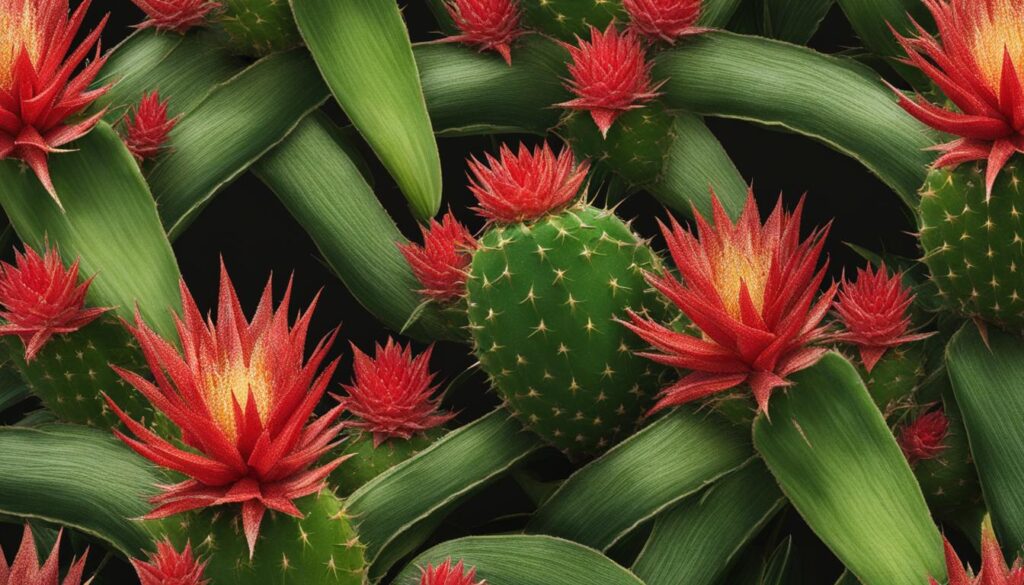Aloe vera, a well-known plant revered for its healing properties, often sparks the question: Is it a cactus? While aloe vera shares some similarities with cacti, it is important to understand their distinct differences in plant classification and anatomy.
Post Summary
- Aloe vera is a succulent plant, not a cactus.
- Aloe vera belongs to the Asphodelaceae (Liliaceae) family.
- Cacti are a specific type of succulent with unique anatomical features.
- Aloe vera has thick, fleshy leaves that store water, while cacti have reduced leaves and spines.
- Understanding the differences can help in the care and cultivation of these plants.
The Difference Between Cacti and Succulents
Cacti and succulents are often confused due to their similar ability to thrive in arid conditions. However, there are distinct differences between the two. Cacti are a specific type of succulent with unique anatomical features that set them apart.
One key difference is the presence of spines. Cacti have spines that grow from specialized structures called areoles, which are unique to cacti. These spines serve multiple purposes, including protection against herbivores and shade from the scorching desert sun. On the other hand, succulents may or may not have spines, and if they do, they are not as prominent or organized as those found on cacti.
Another distinguishing characteristic is the root system. Cacti have shallow, spreading root systems that allow them to quickly absorb water when it becomes available, while succulents may have a range of root adaptations depending on the species. Additionally, cacti have reduced leaves or even no leaves at all, which helps minimize water loss through transpiration. Succulents, on the other hand, have fleshy leaves or stems that can store water and are adapted to retain moisture in their tissues.
Anatomical Differences Between Cacti and Succulents
| Feature | Cacti | Succulents |
|---|---|---|
| Spines | Present, grow from areoles | May or may not be present, not organized like cacti |
| Root System | Shallow, spreading | Varies depending on species |
| Leaves | Reduced or absent | Fleshy, can store water |
It’s important to note that while all cacti are succulents, not all succulents are cacti. The distinction lies in the specific adaptations and anatomical features of cacti that enable them to thrive in harsh desert environments.
Understanding these differences can help enthusiasts and gardeners appreciate the unique characteristics of cacti and succulents and provide the appropriate care for each plant. Whether you’re drawn to the striking spines of cacti or the diverse shapes and colors of succulents, both groups offer a wide range of options for adding beauty and resilience to your indoor or outdoor spaces.
Anatomy of Aloe Vera and Cacti
Aloe vera plants have thick, fleshy leaves that store water. The leaves are the main photosynthetic parts of the plant and can vary in size and shape depending on the species. Cacti, on the other hand, have modified leaves that are often small, ephemeral, or absent altogether. Instead, cacti store water in their stems, which can be cylindrical, columnar, or globular in shape. Cacti also have thorns that grow from specialized structures called areoles. Both aloe vera and cacti undergo photosynthesis to produce energy, but they have different anatomical adaptations for water storage and survival in arid environments.
Comparison of Anatomy of Aloe Vera and Cacti
| Aspect | Aloe Vera | Cacti |
|---|---|---|
| Leaves | Thick, fleshy, vary in size and shape | Modified, often small or absent |
| Stems | N/A | Cylindrical, columnar, or globular |
| Water Storage | Leaves | Stems |
| Thorns | No | Yes, grow from areoles |
| Photosynthesis | Leaves | Stems |
As seen in the table above, aloe vera and cacti have distinct differences in their anatomy. While aloe vera relies on its thick, fleshy leaves for water storage and photosynthesis, cacti have modified leaves and instead store water in their stems. Additionally, cacti have thorns that grow from specialized structures called areoles, whereas aloe vera does not have any thorns. These anatomical adaptations allow both plants to thrive in arid environments, although they have different mechanisms for survival.
Understanding the anatomy of aloe vera and cacti can provide valuable insights into their care and cultivation. It helps to determine the specific needs of each plant regarding watering, light exposure, and overall maintenance. By considering their unique anatomical features, you can create optimal growing conditions and ensure the health and vitality of both aloe vera and cacti in your indoor or outdoor space.
In the image above, you can see visual representations of the anatomical differences between aloe vera and cacti. The labeled parts illustrate the key characteristics mentioned, such as the thick leaves of aloe vera and the spines and stem structures of cacti. These anatomical features play a crucial role in the overall appearance and functionality of each plant, making them fascinating subjects for plant enthusiasts and nature lovers.
Growth Habits of Aloe Vera and Cacti
When it comes to growth habits, aloe vera and cacti exhibit distinct characteristics that contribute to their unique appearances. Aloe vera plants typically grow in individual rosettes, with leaves arranged in a circular pattern. Over time, these rosettes can form dense clusters, creating a visually appealing display. Cacti, on the other hand, have diverse growth forms. Some cacti grow as columns, reaching impressive heights, while others have segmented stems or jointed growth patterns. Certain cacti species can also branch out and form multiple stems, adding to their overall complexity.
In aloe vera plants, the rosette growth habit allows the leaves to efficiently capture sunlight from all angles, aiding in photosynthesis. The circular arrangement of leaves also helps with water retention, as they create a natural basin that traps moisture. In contrast, the various growth forms of cacti serve as adaptations for survival in arid environments. Columnar cacti, for example, have elongated stems that maximize water storage capacity. Segmented and jointed cacti, such as the iconic Prickly Pear, have specialized structures that allow them to expand and contract depending on the availability of water.
To summarize:
- Aloe vera plants grow in rosettes, forming dense clusters over time.
- Cacti have diverse growth forms – columns, segmented stems, jointed growth patterns.
- Aloe vera’s rosette growth allows for efficient sunlight capture and water retention.
- Cacti’s various growth forms are adaptations for survival in arid environments.
By understanding the growth habits of aloe vera and cacti, you can better appreciate their beauty and cater to their specific needs when cultivating them as ornamental plants. Whether you prefer the symmetrical rosettes of aloe vera or the architectural columns and branching patterns of cacti, both plants offer stunning displays that can enhance any garden or indoor space.
| Plant Care | Aloe Vera | Cacti |
|---|---|---|
| Sunlight | Bright, indirect sunlight | Sunny location |
| Watering | Infrequent watering, allow soil to dry out between waterings | Infrequent watering, allow soil to dry out between waterings |
| Soil | Well-draining soil mix with perlite or sand | Well-draining soil mix with perlite or sand |
| Temperature | 65-80°F (18-27°C), avoid cold drafts | 65-80°F (18-27°C), avoid extreme temperature fluctuations |
“Proper care and cultivation can ensure the health and longevity of aloe vera and cacti.”
By following these care tips, you can enjoy beautiful, thriving aloe vera and cacti plants in your home or garden. Remember to monitor their growth and provide the necessary conditions for their specific care requirements. With their unique appearances and ability to thrive in arid environments, aloe vera and cacti are excellent choices for any plant enthusiast.
Differences in Appearance and Leaves
When it comes to appearance, aloe vera and cacti have distinct characteristics that set them apart. Aloe vera plants are known for their thick, fleshy leaves that store water, often growing in a rosette pattern. These leaves can vary in size and shape, but they are typically triangular and range in color from light to dark green. On the other hand, cacti have reduced leaves that are often small and short-lived, or in some cases, absent altogether. Instead of leaves, cacti have spines that grow from specialized structures called areoles.
The presence of spines and leaf reduction are key distinguishing features between aloe vera and cacti. While aloe vera leaves serve as the main photosynthetic organs of the plant, cacti have evolved to rely on their stems for water storage and photosynthesis. This adaptation allows cacti to thrive in arid environments where water is scarce. Additionally, the spines found on cacti serve various purposes, including protection against herbivores and reducing water loss through evaporation.
“Aloe vera plants have thick, fleshy leaves that store water, while cacti have reduced leaves and instead rely on their stems for water storage.”
The differences in appearance and leaf structure between aloe vera and cacti contribute to their overall aesthetics. Aloe vera’s vibrant green leaves and rosette growth habit make it a striking addition to any garden or indoor space. In contrast, cacti’s unique and often intricate spines, along with their diverse stem shapes, create a visually intriguing display. Whether you prefer the lush foliage of aloe vera or the architectural beauty of cacti, both plants offer distinct visual appeal and can be a wonderful addition to any plant collection.
| Plant | Leaves | Spines |
|---|---|---|
| Aloe Vera | Fleshy, triangular, green | No spines |
| Cacti | Reduced or absent | Presence of spines |
Your Aloe Vera and Cacti Care Guide
- Choose the right light: Both aloe vera and cacti thrive in bright, indirect sunlight. Place them near a sunny window or provide artificial grow lights.
- Water sparingly: Aloe vera and cacti are adapted to survive in arid conditions, so they don’t require frequent watering. Allow the soil to dry out between waterings to prevent root rot.
- Use well-draining soil: Both plants prefer soil that provides good drainage. A mixture of potting soil and perlite or sand works well.
- Watch out for pests: Keep an eye out for common pests like mealybugs and aphids. If infestations occur, treat them promptly with insecticidal soap or neem oil.
- Provide appropriate temperatures: Aloe vera and cacti prefer warm temperatures and can tolerate mild fluctuations. Avoid exposing them to extreme cold or frost.
Flowers and Reproduction
The flowers of both aloe vera and cacti are a remarkable feature that adds to their overall beauty and charm. Aloe vera plants produce tubular flowers on tall stalks, typically in vibrant hues of orange, red, or yellow. These flowers are designed to attract pollinators such as bees and butterflies, which play a vital role in the plant’s reproductive cycle. Aloe vera flowers are known for their nectar, which is a rich reward for pollinators seeking food.
“The brightly colored flowers of aloe vera serve as a beacon for pollinators like bees and butterflies, ensuring the continuation of the species through cross-pollination.”
Cacti, on the other hand, have their unique methods of flower production and pollination. Some cacti species bear large, fragrant flowers that bloom at night, attracting nocturnal pollinators such as moths and bats. These flowers often have a short lifespan, but their enchanting fragrance and beauty make them a sight to behold. Other species of cacti have smaller, inconspicuous flowers that are mainly pollinated by bees during the day.
After successful pollination, cacti bear fruits that aid in their reproduction. These fruits, which come in various shapes and sizes, contain seeds that can be dispersed by animals or birds. Aloe vera, on the other hand, primarily reproduces through vegetative methods such as cuttings or division, making it a popular choice for propagation.
A Comparison of Flower Characteristics
| Plant | Flower Characteristics | Pollinators | Reproduction Methods |
|---|---|---|---|
| Aloe Vera | Tubular, brightly colored flowers on tall stalks | Bees, butterflies | Mainly through vegetative methods (cuttings, division) |
| Cacti | Varies by species: large, fragrant flowers or smaller, inconspicuous flowers | Nocturnal pollinators (moths, bats) or bees | Primarily through fruit production and seed dispersal |
Compatibility and Growing Together
Growing aloe vera and cacti together can create an intriguing and visually appealing display in your garden or indoor space. With the right care and optimal growing conditions, these plants can thrive side by side, adding beauty and uniqueness to your plant collection.
To ensure successful growth, it’s important to consider the soil mix, watering, and sunlight requirements for both aloe vera and cacti.
Soil Mix
A well-draining soil mix is crucial for the health of aloe vera and cacti. It helps prevent root rot and allows excess water to drain away effectively. A recommended soil mix is a combination of potting soil and gritty materials such as perlite or sand. This mixture promotes good drainage while providing adequate nutrients for the plants.
Watering
Both aloe vera and cacti are adapted to arid conditions and have low water requirements. It’s important to avoid overwatering, as this can lead to root rot and other issues. Allow the soil to dry out between waterings, and water thoroughly when needed. Remember that it’s better to underwater than to overwater these plants.
Sunlight
Aloe vera and cacti prefer bright, indirect sunlight. While they can tolerate different light levels, it’s essential to provide them with enough light to ensure proper growth and development. Place them in a sunny location such as a south-facing window or a well-lit area in your garden. If growing them indoors, consider using artificial grow lights to supplement natural light.
| Aloe Vera | Cacti |
|---|---|
| Well-draining soil mix | Well-draining soil mix |
| Infrequent watering | Infrequent watering |
| Bright, indirect sunlight | Bright, indirect sunlight |
| Tolerates lower light levels | Prefer sunny location |
By providing optimal growing conditions and ensuring compatibility between aloe vera and cacti, you can create a stunning and harmonious display of these unique plants. Enjoy the beauty and benefits they bring to your space as they thrive and grow together.
Uses of Aloe Vera and Cacti
Both aloe vera and cacti have a wide range of uses, extending beyond their ornamental value. Let’s explore the medicinal, culinary, and other practical applications of these remarkable plants.
Medicinal Uses
“Aloe vera is well-known for its soothing and healing properties, making it a popular ingredient in skincare and medicinal products. It is commonly used to treat burns, skin irritations, and acne.”
The gel extracted from aloe vera leaves contains bioactive compounds that have anti-inflammatory, antibacterial, and wound-healing properties. It can provide relief for various skin conditions, including sunburns, rashes, and dryness. Aloe vera gel is often used topically to soothe and moisturize the skin, promoting its rejuvenation and enhancing its natural glow.
Furthermore, aloe vera gel has been used in traditional medicine to alleviate gastrointestinal issues, such as indigestion and constipation. It is believed to have a soothing effect on the digestive system and can help promote regular bowel movements.
Culinary Uses
In addition to its medicinal benefits, aloe vera gel can also be consumed for its nutritional value. It is rich in vitamins, minerals, and antioxidants, making it a valuable addition to a healthy diet.
Aloe vera gel can be added to smoothies, juices, and other beverages to enhance their nutritional content. It can also be used as an ingredient in culinary dishes, providing a refreshing and slightly sweet taste. However, it is important to note that only the gel should be used, as the latex found just beneath the outer leaf has a bitter taste and may cause digestive discomfort.
Ornamental Uses
Both aloe vera and cacti are prized for their unique shapes, textures, and colors, making them popular choices as ornamental plants.
Aloe vera’s rosette-like growth habit and its ability to form dense clusters make it an attractive addition to gardens, balconies, and indoor spaces. Its striking green leaves create a visually appealing display, and when the plant blooms, it produces tall stalks with vibrant tubular flowers, adding an extra touch of beauty.
Cacti, with their diverse growth forms, offer a range of options for ornamental use. Columnar cacti, such as the iconic Saguaro, can add vertical interest and architectural appeal to landscapes. Cacti with segmented or jointed stems, such as the Christmas Cactus, display unique shapes and often produce colorful flowers. Small, round cacti, like the popular Mammillaria, make charming additions to succulent gardens and indoor collections.
Whether it’s for their healing properties, culinary potential, or aesthetic appeal, aloe vera and cacti have multiple uses that make them valuable and versatile plants. Incorporating these plants into your life can bring natural beauty, health benefits, and a touch of desert charm.
Common Concerns and Tips for Aloe Vera and Cacti Care
When caring for aloe vera and cacti, it’s important to be aware of common concerns and follow some helpful tips to ensure their health and well-being. Here are some key points to consider:
Insects
Aloe vera and cacti can be susceptible to certain insects such as mealybugs and aphids. Regularly inspect the plants for signs of infestation, such as sticky residue or small white bugs. If you notice any pests, gently wipe the leaves or stems with a damp cloth or use an organic insecticidal soap to control the infestation.
Diseases
In addition to insects, aloe vera and cacti can also face certain diseases. Common diseases include scale, leaf spot, and sooty mold. To prevent these diseases, avoid overwatering the plants and ensure they have adequate air circulation. If you notice any signs of disease, remove the affected areas and treat the plants with a fungicide if necessary.
Repotting
As aloe vera and cacti grow, they may need to be repotted to accommodate their root growth. Repotting should be done when the roots become overcrowded and start to outgrow the current container. Choose a pot that is slightly larger and has drainage holes to prevent waterlogged soil. Gently remove the plant from its current pot and place it in the new pot with fresh, well-draining soil.
Sunlight and Watering
Proper sunlight and watering are crucial for the health of aloe vera and cacti. These plants thrive in bright sunlight, so place them in a location where they can receive at least six hours of direct or indirect sunlight per day. When it comes to watering, it’s important to maintain a balance. Allow the soil to dry out completely between waterings and avoid overwatering, as it can lead to root rot. Adjust the watering frequency based on the season and the needs of the plant.
| Plant Care Tips | Aloe Vera | Cacti |
|---|---|---|
| Sunlight | Bright, indirect sunlight | Full sun |
| Watering | Allow soil to dry out between waterings | Water sparingly, allow soil to dry out completely |
| Soil | Well-draining soil mix | Sandy or gritty soil mix |
| Temperature | Warm temperatures, 55-80°F | Warm temperatures, 60-90°F |
| Fertilization | Minimal fertilization, once every few months | Fertilize during the growing season, once a month |
By addressing these common concerns and following the care tips provided, you can ensure that your aloe vera and cacti thrive and continue to beautify your indoor and outdoor spaces for years to come.
Aloe Vera and Cacti as Houseplants
If you’re looking for a low-maintenance and visually appealing houseplant, consider adding aloe vera to your indoor collection. Aloe vera is an excellent choice for indoor cultivation due to its adaptability and ability to tolerate lower light levels compared to outdoor conditions. When caring for aloe vera as a houseplant, it’s important to provide the right amount of sunlight, water, and suitable growing conditions.
When it comes to sunlight requirements, aloe vera thrives in bright, indirect light. Place your aloe vera plant near a window where it can receive several hours of bright, filtered sunlight each day. In areas with limited natural light, artificial grow lights can be used to supplement the plant’s light requirements.
Proper watering is crucial for the health of your aloe vera plant. As a succulent, aloe vera stores water in its leaves, so it is adapted to dry conditions. Water your aloe vera thoroughly but infrequently, allowing the soil to dry out completely between waterings. Overwatering can lead to root rot and other issues, so it’s important to strike the right balance.
| Sunlight | Watering | Soil |
|---|---|---|
| Bright, indirect light | Allow soil to dry out completely between waterings | Well-draining soil mix |
| Aloe vera as a houseplant | ||
In terms of soil, a well-draining mix is essential for aloe vera. Use a cactus or succulent soil mix, or create your own by combining regular potting soil with perlite or sand to improve drainage. A well-draining soil mix helps prevent waterlogged roots and ensures the plant has access to the right amount of moisture.
In addition to sunlight and watering, aloe vera benefits from periodic fertilization during the growing season. Use a balanced, water-soluble fertilizer formulated specifically for succulents, following the instructions on the packaging for application rates and frequency. Fertilize your aloe vera plant sparingly to avoid overfeeding, which can lead to leggy growth.
With proper care and attention to its sunlight, watering, and soil needs, aloe vera can thrive as a houseplant, adding beauty and health benefits to your indoor space. Enjoy the unique appearance and healing properties of aloe vera as you incorporate it into your indoor plant collection.
Conclusion
In conclusion, aloe vera is a succulent plant that is often mistaken for a cactus. While both aloe vera and cacti belong to the broader category of succulents, they have distinct differences in their anatomical features, growth habits, and care requirements. Understanding these differences is crucial for effectively cultivating and caring for these plants.
Aloe vera, with its thick, fleshy leaves, is commonly used for its healing properties and is cultivated for its gel and medicinal uses. It thrives in well-draining soil, bright but indirect sunlight, and infrequent watering. On the other hand, cacti display a variety of growth forms, such as columns, segmented stems, or jointed patterns. With their reduced leaves and spines, cacti are adapted to arid environments.
To ensure the health and longevity of both aloe vera and cacti, it is important to provide them with optimal growing conditions. This includes well-draining soil, ample sunlight, and infrequent watering to prevent root rot. Monitoring for pests and diseases is also essential. Additionally, aloe vera can be grown as a houseplant and can tolerate lower light levels indoors.
Both aloe vera and cacti are fascinating and versatile plants that can enhance any indoor or outdoor space. Whether you’re interested in their medicinal uses, culinary benefits, or simply their unique appearance, with proper care and cultivation, these succulents will thrive and bring beauty and benefits to your plant collection.
Are Echeveria and Graptopetalum Related to Aloe Vera?
Yes, there is an echeveria vs graptopetalum comparison in terms of their appearance and care requirements. While echeveria and graptopetalum belong to the Crassulaceae family, just like aloe vera, they are not directly related. Both echeveria and graptopetalum are succulents with similar rosette shapes and fleshy leaves, but they have their own unique characteristics.
FAQ
Is aloe vera a cactus?
No, aloe vera is a succulent plant that belongs to the Asphodelaceae (Liliaceae) family. While all cacti are succulents, not all succulents are cacti. Aloe vera has thick, fleshy leaves that store water and does not have the characteristic thorns of cacti.
What are the differences between cacti and succulents?
Cacti are a specific type of succulent with unique anatomical features. They have spines that grow from areoles, shallow, spreading root systems, and reduced leaves for water conservation. Succulents, on the other hand, encompass a broader group of plants with fleshy leaves or stems that store water.
What is the anatomy of aloe vera and cacti?
Aloe vera plants have thick, fleshy leaves that store water, while cacti have modified leaves that are often small or absent. Aloe vera stores water in its leaves, and cacti store water in their stems. Cacti also have spines that grow from specialized structures called areoles.
How do aloe vera and cacti grow?
Aloe vera typically grows in rosettes with leaves arranged in a circular pattern, while cacti have diverse growth forms such as columns, segmented stems, or jointed patterns. Some cacti can also branch out and form multiple stems.
How do I care for aloe vera and cacti?
Both plants prefer bright, indirect sunlight, well-draining soil, and infrequent watering. Aloe vera can tolerate lower light levels compared to cacti. It’s essential to allow the soil to dry out between waterings to prevent root rot.
What are the differences in appearance and leaves between aloe vera and cacti?
Aloe vera has thick, fleshy leaves that are often triangular in shape and grow in a rosette pattern. Cacti have reduced leaves and spines that grow from specialized structures called areoles. The presence of spines and leaf reduction differentiate their appearances.
Do aloe vera and cacti produce flowers?
Yes, both aloe vera and cacti produce flowers. Aloe vera plants produce tubular flowers on tall stalks, while cacti have a variety of flower types that can be pollinated by different insects or animals. Cacti also bear fruits that aid in their reproduction.
Can I grow aloe vera and cacti together?
Yes, aloe vera and cacti can be grown together as long as their care requirements are met. They both prefer well-draining soil, ample sunlight, and infrequent watering. Monitoring their growth compatibility and providing sufficient space is important for their health.
What are the uses of aloe vera and cacti?
Aloe vera is well-known for its soothing and healing properties and is commonly used for burns, skin irritations, and acne. It can also be added to culinary dishes and beverages. Some cacti, like the Prickly Pear, have traditional uses for their anti-inflammatory and antioxidant properties. Both plants have ornamental value.
What are common concerns and tips for aloe vera and cacti care?
Aloe vera and cacti can be susceptible to insects like mealybugs and aphids, as well as diseases like scale and leaf spot. Adequate sunlight, well-draining soil, and proper watering practices are essential for their health. Repotting should be done when the roots are overcrowded.
Can aloe vera be grown as a houseplant?
Yes, aloe vera is a popular choice as a houseplant due to its ease of cultivation and low maintenance requirements. It can tolerate lower light levels compared to outdoor conditions and requires a well-draining soil mix and infrequent watering.












